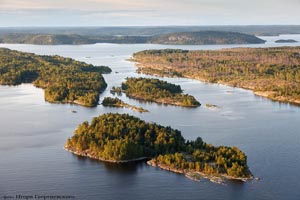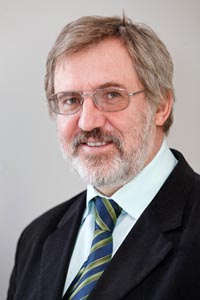"Êàðåëèÿ", ¹ 29 îò 18 àïðåëÿ 2013 ã.
 Year 2013 – the Environment Year
Year 2013 – the Environment YearTwenty years ago scientists from Karelia and Finland put forward the idea of establishing the Green Belt of Fennoscandia. It is a chain of protected areas (PAs) along the Russian-Finnish and Russian-Norwegian border. In turn, the Green Belt of Fennoscandia is a component part of the European Green Belt, which is a set of national and nature parks, biosphere reserves and other protected areas along the border of the countries once separated by the notorious “Iron Curtain”.
Dr. Alexandr Kryshen’, Acting Director of the KarRC of RAS Forest Research Institute and Chairman of the Environment Council under the Karelian Research Centre Presidium, told us about the implementation of this idea.
 Alexandr Mikhailovich, can one now, after twenty years, announce that the goal has been achieved – the Green Belt of Fennoscandia has generally been established?
Alexandr Mikhailovich, can one now, after twenty years, announce that the goal has been achieved – the Green Belt of Fennoscandia has generally been established? – It’s both yes and no. As a chain of federally and regionally subordinated PAs it mainly has. Even here though not everything was a success. In addition to the existing PAs the Ladoga Skerries and Tulos were to become key elements of the belt. Alas, this hasn’t happened yet.
We have moved from viewing the Green Belt of Fennoscandia as a chain of PAs along the border to the concept of a territory where the tasks of conserving the natural and cultural heritage (the latter being especially topical in the Ladoga region and Kalevasky District) are interlocked with the socio-economic development of municipalities. Such integrated approach to the old concept is very demanding, and there isn’t much we can report yet in this sense.
Equally important is that the Green Belt of Fennoscandia is a part of the PA system of the European North of Russia. The backbone of this system is made up of several green belts. One of them – the White Sea-Onega belt – comprises protected areas in the Murmansk, Arkhangelsk, Vologda Regions and Republic of Karelia. To wit, it includes the Vodlozersky and Kenozersky National Parks
– One of the pioneers, established in 1992, was the Paanajärvi National Park, which fit perfectly into the “green belt”. Is it true that the nature is at rest there?
– Paanajärvi National Park occupies a big territory. According to the zoning scheme, parts of the park are to be used for recreational purposes. There are also core areas, where the nature actually “rests” from people.
The condition of recreational zones should certainly be constantly and closely monitored. In spite of the distances, Paanajärvi is actively visited by tourists – not just from European countries as forecasted, but also from Russia. Karelian scientists carried out a special study and found that for far there are no reasons to limit the numbers of visitors to these areas.
– Another key element of the Karelian stretch of the Green Belt of Fennoscandia is the Ladoga Skerries National Park. What are the difficulties faced in the course of its establishment?
– Something weird is happening with the Ladoga Skerries. The planned National Park has turned into a “bargaining chip” in some games. Let’s think who may be disadvantaged by the park? Local people? Dacha owners? All properly drawn up land parcels with residential structures and summer cottages, as well as all other lands belonging to the settlement category (including agricultural land) have been excluded from the park, and their price is sure to grow following the designation. Hence, owners of such land cannot lose here. The ones to bear losses are those who have taken possession of land and fenced it out either unauthorized or with connivance of officials. But I beg pardon, they must be driven away even without any park … Obviously, others to get hurt will be poachers, black loggers …
One must also realize that once the National Park is established many people will get jobs with regular salaries from the federal budget, tourist firms will get more clients, farms – new consumers for their products, regional lore specialists – a tool to preserve cultural heritage… That will mean at least potential for the development of the area. Instead of calmly and thoughtfully looking in depth of these matters one instigates campaigning passions.
– Is there any such experience in other regions?
– In other regions the initiative to establish a PA to save the nature from barbaric utilization usually comes from local people, who realize that national parks, nature reserves and other PA forms don’t deprive local people of their traditional berry-picking, mushroom-gathering, fishing and hunting grounds.
Five years ago the conference on the Green Belt of Fennoscandia adopted the resolution in which the participants turned to the Russian Federation Government with the suggestion to establish three national parks: in the Murmansk Region – Khibiny, Arkhangelsk Region – Onezhskoe Pomorje, and in Karelia – Ladoga Skerries. We can congratulate our neighbours – the Onezhskoe Pomorje NP in the Arkhangelsk Region was approved for designation late in February. The project plan of the national park designation in the Murmansk Region is widely supported.
The situation with the Ladoga Skerries has demonstrated how important it is to have active local conservation NGOs. Although a dozen a half such organizations are registered in Karelia they can’t always make themselves heard. Conservation activists in Lahdenpohsky District speak the same language with local people, and the majority is thus in favour of the park. Somehow, we hardly ever hear of environmentalists from Sortavala. Meanwhile, it was Sortavala people who actively supported the Ladoga Skerries NP nomination in the 1990s.
No wonder the park’s opponents are more active than its supporters. Those who oppose the obvious have to be more active and inventive to “muddy the waters”.
– Is it true that ecotourism, which invades in PAs, does not upset the frail ecological balance? Knowing that this recreational activity may also involve fishing, hunting...
– Eco-tourism suggests that one not only enjoys the nature but also takes care to conserve it. As defined by WWF, ecotourism embraces travel to natural areas involving appreciation not only of nature, but also of indigenous cultures prevailing in natural areas. This form of tourism does not shatter the ecosystems, simultaneously creating the economic conditions in which local people benefit from conserving the nature and natural resources. There is certainly an economic dimension to this definition. One must realize however that if wisely organized and regulated hunting and fishing don’t really harm the nature.
– Is the PA network on the other side of the border developing problem-free?
– Naturally, we see the problems our neighbours have in building the Green Belt of Fennoscandia. We don’t interfere however.
There’s another thing I’d like to stress. Nearly all large borderline PAs on the Russian side have “twins” on the other side. E.g., the Pasvik Strict Nature Reserve in the Murmansk Region and the PAs adjoining it on the Finnish and Norwegian side have been joined into the Pasvik-Inari trilateral park, founded in 2008. Kostomukshsky Strict Nature Reserve is part of the Russian-Finnish Friendship Park. Paanajärvi shares the ecosystem with the Oulanka park. There are plans for set up the Finnish “twin” for our Kalevalsky National Park. Let me repeat that we no longer view the Green Belt of Fennoscandia as just a chain of PAs. This is first of all the territory where man and nature are in harmony.
Each country faces certain difficulties when establishing PAs. We intend to discuss our problems at the “Green Belt of Fennoscandia” conference. It’s one of the national Environment Year events included in the federal list. We will share experiences, verify concepts, outline future prospects …
The ideologists of the Green Belt of Fennoscandia have always seen Ladoga Skerries and Tulos among its major elements. Scientists have prepared feasibility studies for both PAs. We hope common sense will take over, and we’ll soon reach a formal completion of the Green Belt PA network establishment. From now on, as has been said, we shall develop it as integral environmental-economic space.
Interview taken by Sergey Khokhlov



